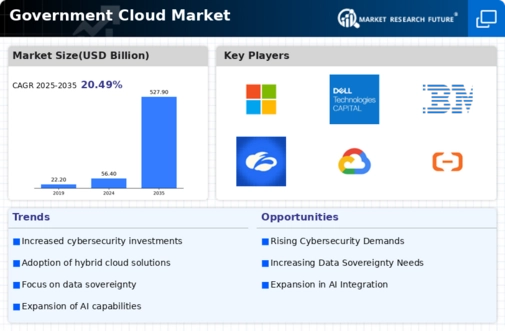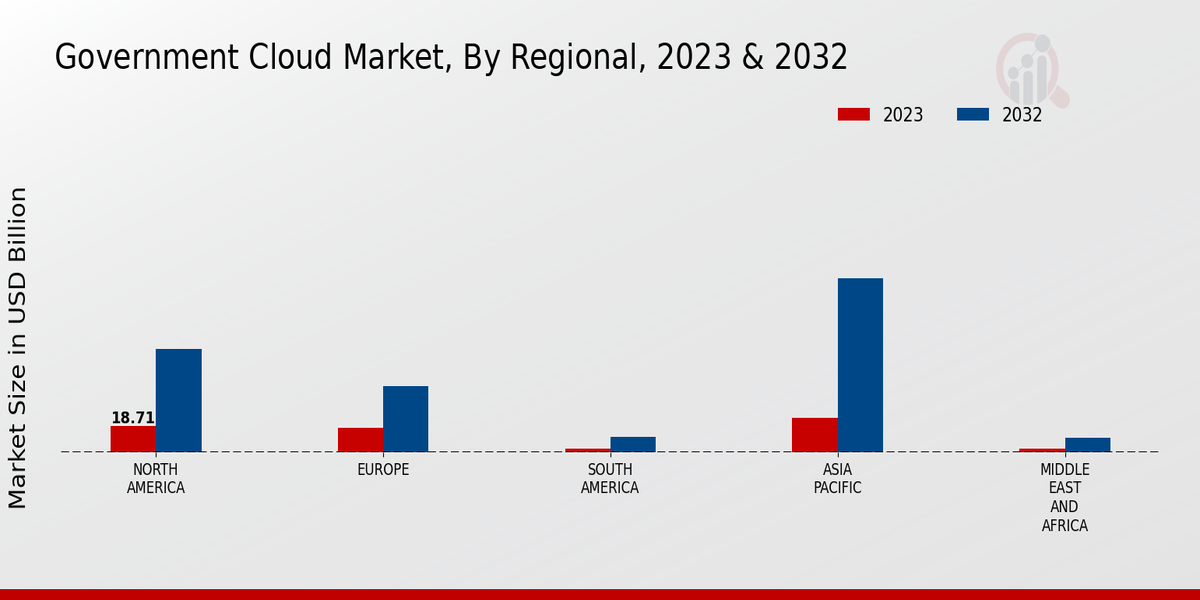Market Growth Projections
The Global Government Cloud Market Industry is poised for substantial growth, with projections indicating a rise from 56.4 USD Billion in 2024 to an impressive 527.9 USD Billion by 2035. This remarkable increase reflects a compound annual growth rate of 22.54% from 2025 to 2035, underscoring the accelerating pace of cloud adoption among government entities. The growth trajectory suggests that governments are increasingly recognizing the strategic advantages of cloud technologies, including scalability, flexibility, and enhanced service delivery capabilities.
Emerging Technologies and Innovation
The integration of emerging technologies such as artificial intelligence and machine learning into the Global Government Cloud Market Industry is fostering innovation. Governments are exploring how these technologies can enhance decision-making processes, improve service delivery, and optimize resource allocation. The potential for cloud-based platforms to leverage big data analytics is particularly noteworthy, as it enables agencies to derive actionable insights from vast amounts of information. As these technologies evolve, they are likely to drive further adoption of cloud solutions, contributing to the anticipated market growth.
Enhanced Data Security and Compliance
Data security remains a paramount concern for governments, leading to a surge in the Global Government Cloud Market Industry. Cloud providers are investing heavily in advanced security measures to ensure compliance with stringent regulations. Governments are increasingly adopting cloud solutions that offer robust security features, such as encryption and multi-factor authentication. This focus on security is crucial, as agencies handle sensitive information that requires protection from cyber threats. The anticipated growth of the market underscores the importance of secure cloud environments in maintaining public trust and safeguarding data.
Increased Demand for Digital Services
The Global Government Cloud Market Industry experiences heightened demand for digital services as governments worldwide seek to enhance operational efficiency and citizen engagement. This shift towards digitalization is driven by the need for real-time data access and improved service delivery. For instance, various governments are adopting cloud solutions to streamline processes, reduce costs, and improve transparency. The market is projected to reach 56.4 USD Billion in 2024, indicating a robust growth trajectory as agencies increasingly recognize the potential of cloud technologies to transform public services.
Cost Efficiency and Budget Optimization
Cost efficiency is a driving force behind the adoption of cloud solutions in the Global Government Cloud Market Industry. By migrating to cloud infrastructures, governments can significantly reduce operational costs associated with maintaining on-premises systems. This transition allows for better budget optimization, enabling agencies to allocate resources more effectively. The projected compound annual growth rate of 22.54% from 2025 to 2035 highlights the increasing recognition of cloud solutions as a means to achieve fiscal responsibility while enhancing service delivery.
Interoperability and Integration Challenges
Interoperability remains a critical challenge within the Global Government Cloud Market Industry. As various agencies adopt different cloud solutions, the need for seamless integration becomes apparent. Governments are increasingly seeking platforms that facilitate interoperability among disparate systems, ensuring data can be shared and accessed efficiently. This challenge may hinder the full realization of cloud benefits, yet it also presents opportunities for innovative solutions that address integration issues. The market's growth may depend on the development of standards and frameworks that promote interoperability across government cloud environments.











